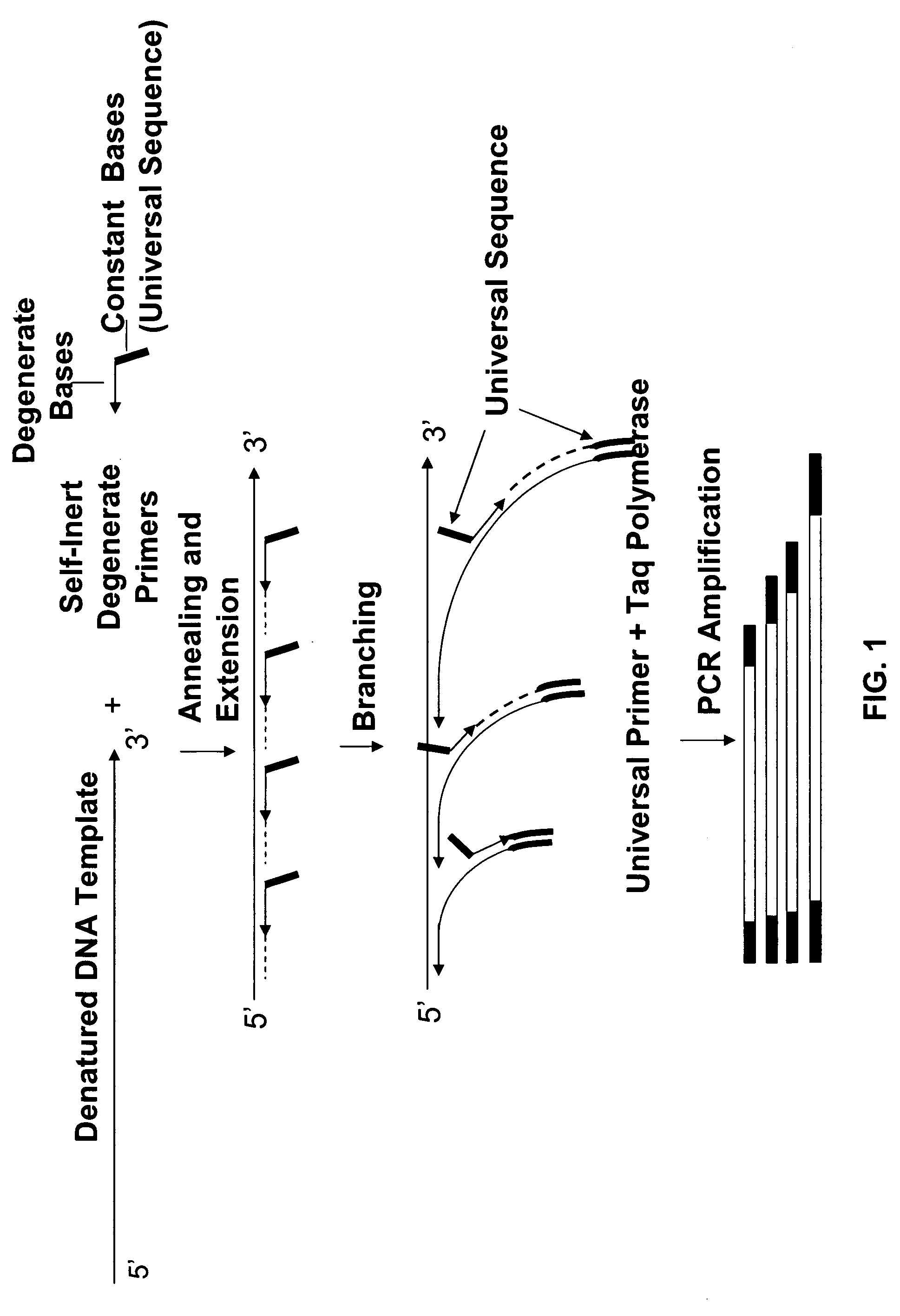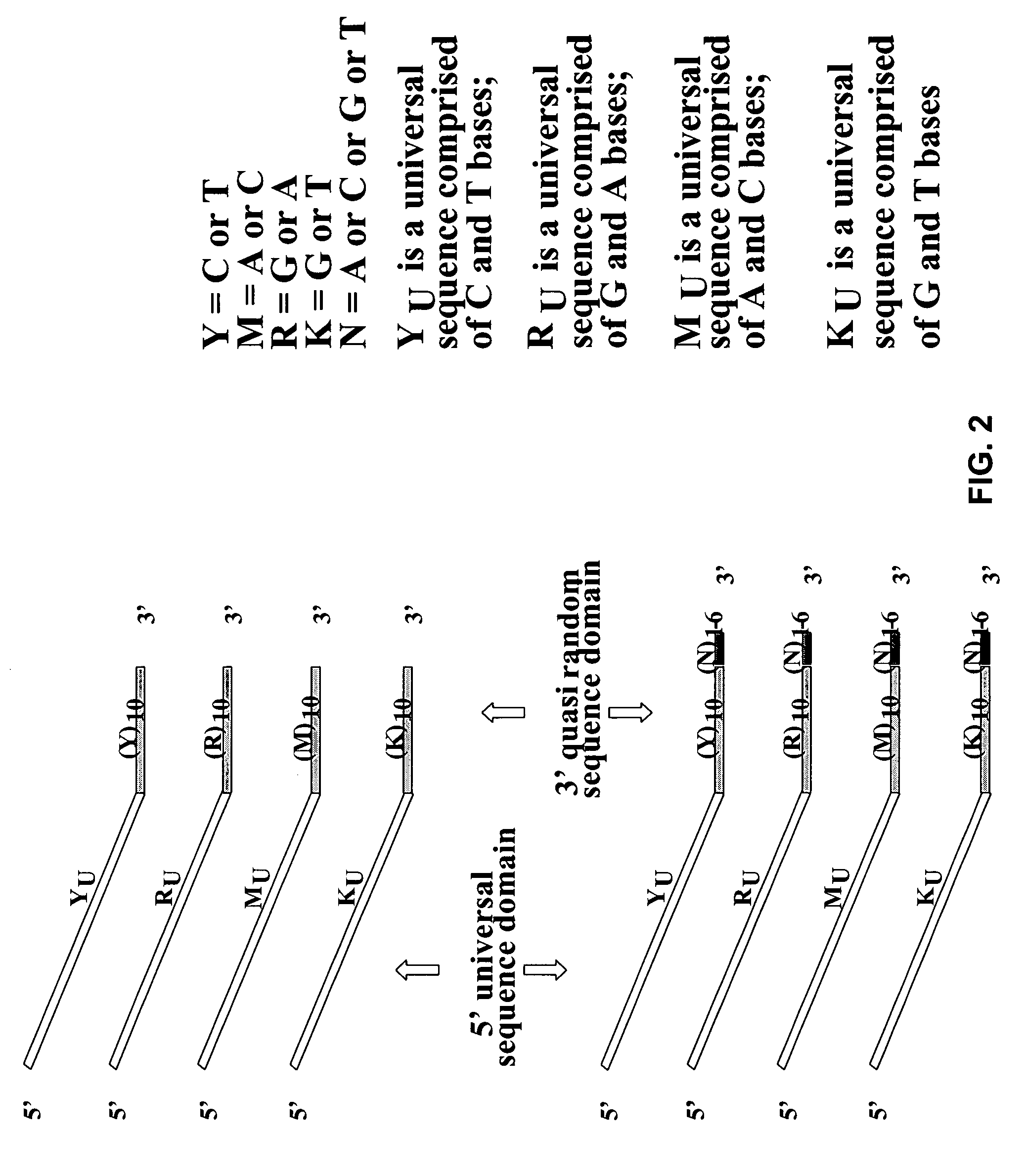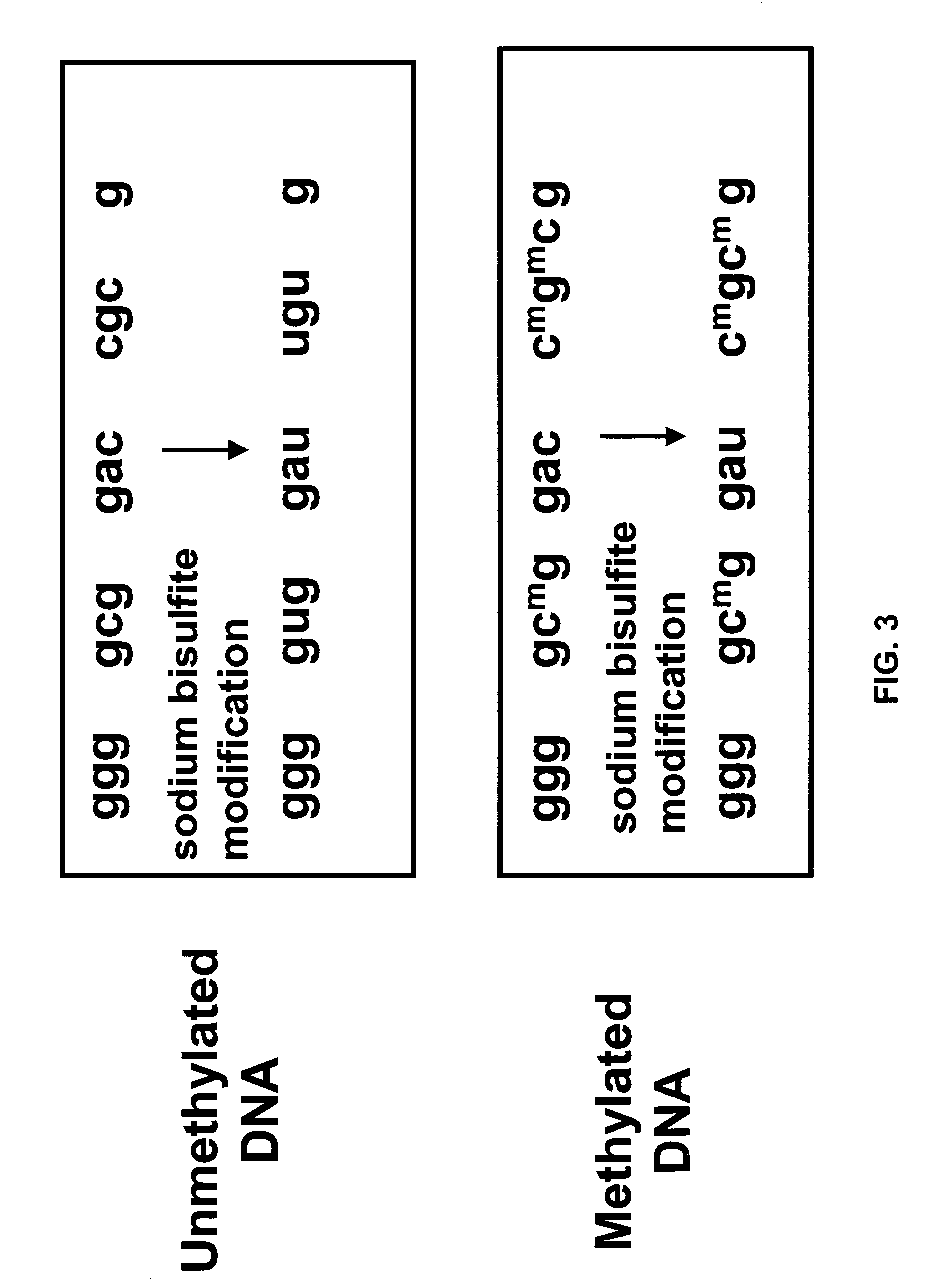Hypermethylation of
gene promoter and upstream coding regions results in decreased expression of the corresponding genes.
While a small
list of commonly hypermethylated sites are being routinely screened as potential sites of interest in many cancers, there is a current lack of methodologies for discovering new sites of interest that may play critical roles in the development and / or progression of
cancer.
There is also a lack of rapid and accurate methodologies for determining the methylation status of specific genes for use as diagnostic, treatment, and prognostic tools for
cancer patients.
While both hypermethylation and hypomethylation have been implicated in the development and progression of several cancers, their specific roles have not been fully elucidated.
Both of these methods are hampered by the requirement for a large amount of starting material, 2.5 □ g for HPLC and 1 μg for HPCE.
Furthermore, these methods also require specialized, expensive equipment.
The major drawback to
bisulfite conversion of DNA is that it results in up to 96% degradation of the DNA sample (Grunau et al., 2001).
Furthermore, the high levels of degradation complicate the detection of differences in methylation patterns in DNA samples from
mixed cell populations, for example cancer cells in a background of normal cells.
Changing the incubation conditions in order to minimize
DNA degradation can result in incomplete conversion and the identification of false positives.
One drawback to
direct sequencing is the necessity to design amplification and sequencing primers that are based on all of the possible sequences depending on the level of methylation.
Furthermore, sequencing is a labor intensive and time-consuming activity if one is investigating large numbers of sequences and / or large numbers of samples.
The major drawback of these techniques is the necessity to design primers specific for each
methylation site that are based on the different converted sequence possibilities.
However, this method is also susceptible to incomplete conversion of the starting DNA.
Methylated sequences will not bind the blocker and will be primed and extended, resulting in cleavage of the probe and fluorescent detection.
This requirement will greatly increase the difficulty and cost of developing site-specific assays.
Furthermore, small samples of DNA will only yield enough material for a few assays and will not allow analysis of large numbers of potential methylation sites.
All of the aforementioned methods that can be used to analyze
bisulfite-converted DNA require several nanograms of converted DNA per
assay and are thus impractical for genomewide
methylation analysis.
The disadvantages of the Southern blotting
assay is that specific probes must be developed for every site of interest and large amounts of starting DNA (ex: 10 μg) are required.
The overall limitation of these technologies is their dependence on the presence of a methylation-sensitive
restriction site present at the CpG of interest.
Thus, although these assays are relatively quick and simple, they cannot be used to test all potential methylation sites.
Furthermore, these methods can only be used for analysis of sites that have been previously identified and have had detection assays designed for them, and they do not allow for the discovery of new sites of interest.
This method greatly improved on the sensitivity of PCR-based methods of analysis, but is greatly hindered by the necessity of creating 2 primers for each loci of interest, and the requirement for analyzing 1 specific site per reaction.
This method requires the generation of a large number of clones for creation of the array and is limited by the ability to amplify the products of the original
digestion.
Many fragments will be either too large to be amplified, or be so small as to result in suppression of amplification or poor hybridization to the array.
Furthermore, there will be a high level of background of products that do not contain methylation sites of interest that will affect the
signal to
noise ratio of the array hybridization.
Drawbacks of these methods are the lack of complete coverage of all regions of the
genome during the initial restriction digest, generation of false positive results due to incomplete cleavage by a methylation-sensitive
restriction enzyme, inability to analyse nicked, degraded, or partially double-stranded DNA from body fluids, as well as lack of quantitation and relatively low sensitivity.
Thus, these techniques are limited to applications in which large quantities of DNA are readily available and methylated DNA represents high percentage of the total DNA.
The drawbacks of these techniques include a requirement for a large amount of starting material, the difficulty of resolving complex samples containing cells with different methylation patterns, and the large amount of work necessary to identify all of the bands of interest.
Furthermore, although this technique is reproducible, sequence variations between samples can result in
gain or loss of cleavage sites, resulting in changes in the banding pattern that are not related to changes in methylation.
Although this protocol has been useful in the identification of specific methylation differences between cancer and normal samples, there are several limitations inherent in this methodology.
The limitations of this technology include the requirement for two restriction
endonuclease sites within close enough proximity to allow PCR amplification, but not so close as to result in suppression of the resulting products.
Furthermore, RDA produces only enrichment of sequences and does not completely select against sites that are methylated as some tester / tester hybrids are formed even in the presence of a large excess of driver.
However, this method is even more limited than MS-RDA in that appropriate isoschizomers for methylated restriction sites are required to produce the libraries.
However, MSLL is a low-
throughput technology that is limited by the constraints of sequencing large numbers of clones that will contain many repeats of the same
insertion sequences.
While this protocol is aimed at universal detection of global methylation patterns through use of McrBC, it involves a subtractive procedure and does not allow the amplification of the products following subtraction and isolation.
Furthermore, there are no mechanisms for amplifying or selecting molecules based on their methylation status.
The method described above suffers from the inherent drawbacks of all techniques based on
bisulfite conversion, namely reduced sensitivity due to significant loss of DNA during the process of bisulfite conversion that compromises the analysis of clinical samples containing only small percentage of methylated DNA in a vast majority of non-methylated DNA , as well as problems implementing the method to
assay methylation in
clinical settings due to multiple and complex preparation steps.
Although this technology can accurately determine the methylation status of a gene
promoter and allows for the discovery of new sites of interest, it suffers from limitations such as the requirement for significant amount of starting DNA material, inability to process multiple samples simultaneously, and dependence on the presence of a methylation-sensitive
restriction site present at the CpG of interest.
This is limited by dependence on the presence of a methylation-sensitive
restriction site present at the
CpG site(s) of interest and that this procedure can only be used for analysis of sites that have been previously identified.
Thus, it does not allow for the discovery of new methylation sites of interest.
This method is limited to the availability of suitable restriction sites and requires significant amounts of input DNA for analysis of multiple restriction sites.
In addition, it depends on the complicated design and empirical testing of primers for each of thousands of potentially methylated sites required for successful profiling, each with very high
GC content.
While this method can amplify DNA regionally while retaining the methylation information of pre-designed sites, amplification of DNA in linear mode is a slow and inefficient process, as opposed to exponential amplification.
Furthermore, the amount of input DNA required for the procedure is still significant.
In addition, this method is limited to regions for which prior knowledge of methylation is known.
Thus, it cannot be applied for genome-wide screening of methylation patterns.
This method can be used for simultaneous analysis of metylation at multiple promoters but requires prior knowledge of sequences, empirical testing of multiple primers for compatibility and has limited application for clinical diagnostics.
As other methods in the art based on conversion with
sodium bisulfite the method described in this patent is limited to using only relatively large amounts of input DNA and requires design of complex
oligonucleotide probes that are difficult to make compatible in a
multiplex reaction.
The methods described in these patents require
microgram quantities of DNA and involve multiple steps including 3 overnight digestions and 3 purification steps They also suffer from additional drawbacks such as the lack of complete coverage of all regions of the genome during the initial restriction digest.
Regions with
low density of cleavage sites will not be amplified and their methylation status could not be determined using this technology.
Incomplete cleavage by methylation-sensitive
restriction enzyme will produce false positive results.
Also, if the DNA source is nicked or degraded or only partially double-stranded as is often the case with DNA in
blood circulation or other body fluids, cleavage with
restriction enzyme will be inefficient and the method will perform poorly.
In addition, the method of detection by
microarray hybridization employed in these techniques is not quantitative and has limited
dynamic range and low sensitivity.
Thus, the methods described in these patents are limited to applications in which large quantities of DNA are readily available and methylated DNA represents high percentage of the total DNA.
First, a 4-bp
recognition sequence restriction
enzyme only cleaves on average every 256 base pairs, so methods that rely on such cleavage prior to adaptor
ligation will not be applicable to any mononucleosomal sized fragments and to only a minority of dinucleosomal sized fragments.
Second, there are no descriptions in the art for converting heavily damaged DNA containing nicks or single-stranded gapped regions into amplifiable molecules that retain methylation information.
These limitations of the art preclude effective
methylation analysis of DNA from non-invasive clinical sources such as serum,
plasma, and
urine, since a majority of the DNA may remain in an unamplifiable form.
 Login to View More
Login to View More 


